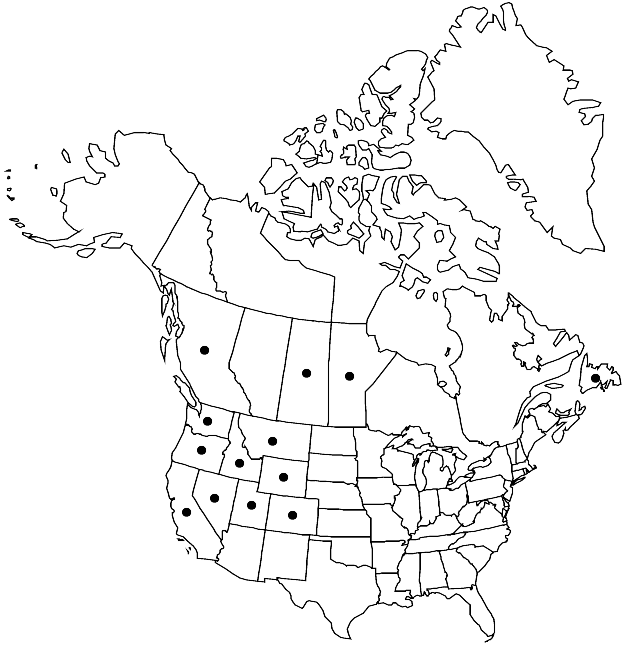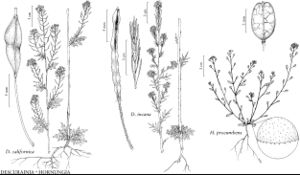Difference between revisions of "Hornungia procumbens"
Repert. Spec. Nov. Regni Veg. Beih. 30: 480. 1925.
FNA>Volume Importer |
imported>Volume Importer |
||
| (3 intermediate revisions by 2 users not shown) | |||
| Line 10: | Line 10: | ||
|name=Lepidium procumbens | |name=Lepidium procumbens | ||
|authority=Linnaeus | |authority=Linnaeus | ||
| + | |rank=species | ||
|publication_title=Sp. Pl. | |publication_title=Sp. Pl. | ||
|publication_place=2: 643. 1753 | |publication_place=2: 643. 1753 | ||
| Line 16: | Line 17: | ||
|name=Capsella elliptica | |name=Capsella elliptica | ||
|authority=C. A. Meyer | |authority=C. A. Meyer | ||
| + | |rank=species | ||
}} {{Treatment/ID/Synonym | }} {{Treatment/ID/Synonym | ||
|name=Capsella procumbens | |name=Capsella procumbens | ||
|authority=(Linnaeus) Fries | |authority=(Linnaeus) Fries | ||
| + | |rank=species | ||
}} {{Treatment/ID/Synonym | }} {{Treatment/ID/Synonym | ||
|name=Hutchinsia procumbens | |name=Hutchinsia procumbens | ||
|authority=(Linnaeus) Desvaux | |authority=(Linnaeus) Desvaux | ||
| + | |rank=species | ||
}} {{Treatment/ID/Synonym | }} {{Treatment/ID/Synonym | ||
|name=Hymenolobus divaricatus | |name=Hymenolobus divaricatus | ||
|authority=Nuttall | |authority=Nuttall | ||
| + | |rank=species | ||
}} {{Treatment/ID/Synonym | }} {{Treatment/ID/Synonym | ||
|name=Hymenolobus erectus | |name=Hymenolobus erectus | ||
|authority=Nuttall | |authority=Nuttall | ||
| + | |rank=species | ||
}} {{Treatment/ID/Synonym | }} {{Treatment/ID/Synonym | ||
|name=Hymenolobus procumbens | |name=Hymenolobus procumbens | ||
|authority=(Linnaeus) Nuttall | |authority=(Linnaeus) Nuttall | ||
| + | |rank=species | ||
}} {{Treatment/ID/Synonym | }} {{Treatment/ID/Synonym | ||
|name=Noccaea procumbens | |name=Noccaea procumbens | ||
|authority=(Linnaeus) Reichenbach | |authority=(Linnaeus) Reichenbach | ||
| + | |rank=species | ||
}} {{Treatment/ID/Synonym | }} {{Treatment/ID/Synonym | ||
|name=Thlaspi procumbens | |name=Thlaspi procumbens | ||
|authority=(Linnaeus) Wallroth | |authority=(Linnaeus) Wallroth | ||
| + | |rank=species | ||
}} | }} | ||
|hierarchy=Brassicaceae;Brassicaceae tribe Descurainieae;Hornungia;Hornungia procumbens | |hierarchy=Brassicaceae;Brassicaceae tribe Descurainieae;Hornungia;Hornungia procumbens | ||
| Line 52: | Line 61: | ||
|elevation=0-2600 m | |elevation=0-2600 m | ||
|distribution=B.C.;Man.;Nfld. and Labr. (Nfld.);Sask.;Calif.;Colo.;Idaho;Mont.;Nev.;Oreg.;Utah;Wash.;Wyo.;Europe;Asia;n Africa;introduced also in Mexico;South America;s Africa;Australia. | |distribution=B.C.;Man.;Nfld. and Labr. (Nfld.);Sask.;Calif.;Colo.;Idaho;Mont.;Nev.;Oreg.;Utah;Wash.;Wyo.;Europe;Asia;n Africa;introduced also in Mexico;South America;s Africa;Australia. | ||
| + | |introduced=true | ||
|discussion=<p><i>Hornungia procumbens</i> is highly variable, especially in fruit size and shape, number of seeds per fruit, indumentum, plant size, and shape and number of leaf divisions. Many of its morphological extremes were recognized at specific and infraspecific ranks, and more than 40 synonyms exist.</p> | |discussion=<p><i>Hornungia procumbens</i> is highly variable, especially in fruit size and shape, number of seeds per fruit, indumentum, plant size, and shape and number of leaf divisions. Many of its morphological extremes were recognized at specific and infraspecific ranks, and more than 40 synonyms exist.</p> | ||
|tables= | |tables= | ||
| Line 61: | Line 71: | ||
-->{{#Taxon: | -->{{#Taxon: | ||
name=Hornungia procumbens | name=Hornungia procumbens | ||
| − | |||
|authority=(Linnaeus) Hayek | |authority=(Linnaeus) Hayek | ||
|rank=species | |rank=species | ||
| Line 77: | Line 86: | ||
|publication year=1925 | |publication year=1925 | ||
|special status= | |special status= | ||
| − | |source xml=https:// | + | |source xml=https://bitbucket.org/aafc-mbb/fna-data-curation/src/2e0870ddd59836b60bcf96646a41e87ea5a5943a/coarse_grained_fna_xml/V7/V7_839.xml |
|tribe=Brassicaceae tribe Descurainieae | |tribe=Brassicaceae tribe Descurainieae | ||
|genus=Hornungia | |genus=Hornungia | ||
Latest revision as of 22:36, 5 November 2020
Plants glabrous throughout or puberulent, trichomes usually minutely forked, some simple. Stems (0.2–)0.5–2.2(–3) dm. Basal leaves: petiole (0.2–)0.5–1.2(–2) cm; blade obovate, oblanceolate, or oblong, (0.2–)1–2.5(–4) cm × (1–)5–11(–16) mm, base cuneate or attenuate, apex acute or obtuse. Cauline leaves (distal) subsessile; blade similar to basal (smaller distally). Racemes few- to several-flowered (rachis straight or slightly flexuous in fruit). Fruiting pedicels 3–8(–12) mm. Flowers: sepals 0.6–1.1 × 0.4–0.6 mm; petals 0.6–1.2 × 0.3–0.6 mm; filaments (white), 0.5–1 mm; anthers ca. 0.1 mm. Fruits (0.2–)0.3–0.4(–0.5) cm × (1–)1.4–2.2 mm, apex subtruncate to slightly emarginate. Seeds 0.5–0.6 × 0.3–0.4 mm. 2n = 12, 24.
Phenology: Flowering Feb–Jul.
Habitat: Deserts, meadows, shade of bushes, disturbed habitats, waste places, saline banks, salt marshes, sagebrush plains, alkaline flats, slopes
Elevation: 0-2600 m
Distribution

Introduced; B.C., Man., Nfld. and Labr. (Nfld.), Sask., Calif., Colo., Idaho, Mont., Nev., Oreg., Utah, Wash., Wyo., Europe, Asia, n Africa, introduced also in Mexico, South America, s Africa, Australia.
Discussion
Hornungia procumbens is highly variable, especially in fruit size and shape, number of seeds per fruit, indumentum, plant size, and shape and number of leaf divisions. Many of its morphological extremes were recognized at specific and infraspecific ranks, and more than 40 synonyms exist.
Selected References
None.
